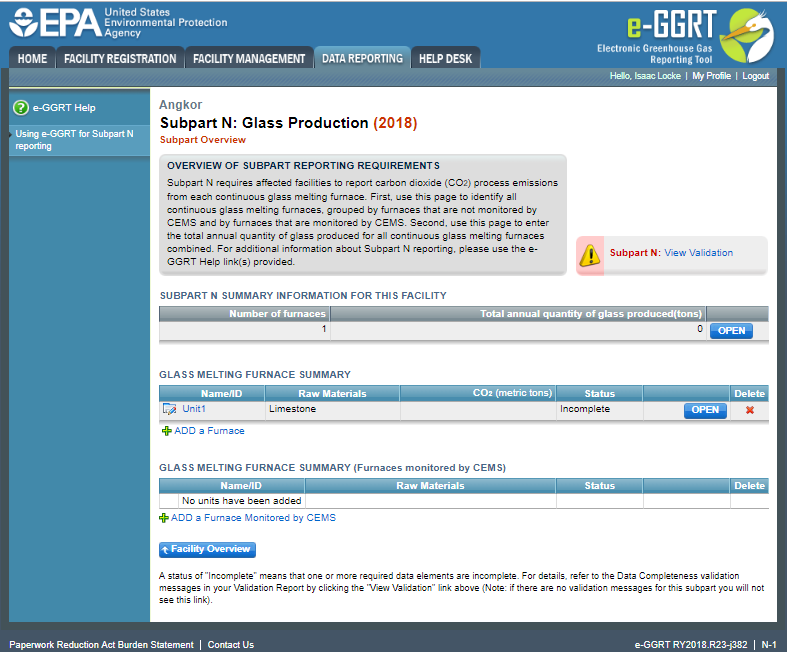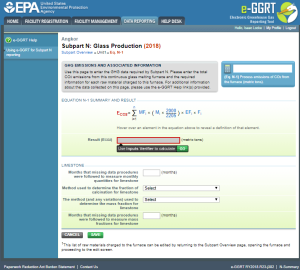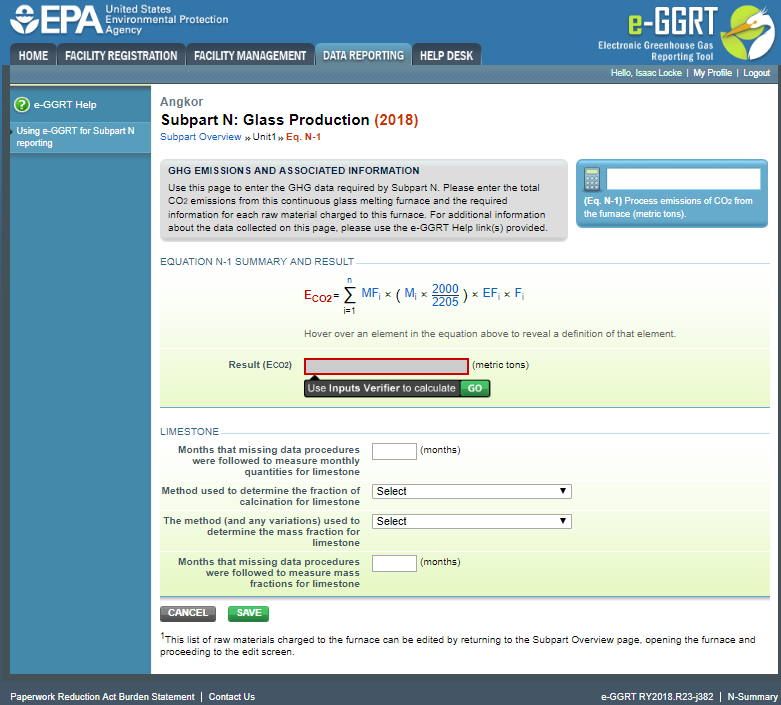This page provides step-by-step instructions on how to enter and edit Subpart N Glass Production emissions information for furnaces that are NOT monitored by a Continuous Emissions Monitoring System (CEMS).
Note: Subpart N is for reporting process related CO2 emissions, combustion CO2 emissions should be reported under Subpart C.
Step 1: Select a furnace
To select a furnace for which to enter emissions data, find the unit in the GLASS MELTING FURNACE SUMMARY table and click OPEN. You will then be on the Eq. N-1 form.
Click this link to expand
Step 2: Equation Summary and Result
For each glass melting furnace NOT monitored by CEMS, enter the CO2 process emissions in metric tons. Be sure to check the units. This number is the output of Equation N-1.
For assistance in calculating CO2 process emissions for a furnace using Eq. N-1, access the calculation spreadsheet for this subpart by clicking the link located below the red emissions data entry box titled "Use Inputs Verifier to calculate, GO" then follow the provided instructions.
Click this link to expand
Step 3: Raw Material Data
For each raw material charged to each glass melting furnace, provide the following:
- The number of months during the reporting year that you followed missing data procedures for the monthly quantities of the raw material
- The method you used to determine the decimal fraction of calcination for the raw material (Default Value (1.0), Chemical analysis using x-ray fluorescence, or Other). If you select "Other", you must specify the method you used in the field provided.
- The number of months during the reporting year that you followed missing data procedures for the mass fractions of the raw material
Step 4: Mass Fraction Verification Test Data
For each mass fraction verification test conducted for each raw material, provide the following:
- The test date.
- The method(s) and any variations used in the analyses (Default method per 98.143(c) or Other). If you select "Other", you must specify the method used in the field provided. Please review 98.143(c) and 98.144(b) for applicable methods.
- The average mass fraction values for all test samples recorded during the test (mass fraction should be expressed as a decimal value from 0.0 to 1.0). If you chose to use the default as an alternative to supplier data, enter 1.0 in the TEST SAMPLE(S) section, consistent with the default value provided in 98.143(c) for “Mass fraction of sample”.
To add mass fraction verification tests for a raw material, click "Add A Test" and enter the required information shown below.
When you have finished entering tests, click SAVE.
Click this link to expand
Step 5: Save emissions and raw material data for a furnace
When you have finished entering emissions and raw material data, click SAVE. You will then return to the Subpart Overview page and you should see the status of data entry for the furnace has changed to “Complete” in the Status column in the GLASS MELTING FURNACE SUMMARY table.
If you do not have all the data it will remain incomplete. You can always enter some now, save it, then finish it later.
After you save the data on this page, the next time you open the page, the calculator on the top of the page will display the CO2 process emissions for the furnace, rounded to the nearest 0.1 of a metric ton. The value displayed is for informational purposes only.
Click this link to expand
Step 6: Repeat Steps 1-5
Repeat Steps 1-5 until emissions data have been entered for all furnaces NOT monitored by CEMS.
See Also
Subpart N Emissions Information for Furnaces NOT Monitored by CEMS for RY2014 and Later
- Subpart N Emissions Information for Furnaces Monitored by CEMS for RY2014 and Later
- Subpart N Emissions Information for Furnaces NOT Monitored by CEMS for RY2014 and Later
- Subpart N Furnace Information for RY2014 and Later
- Subpart N Summary Information for this Facility for RY2014 and Later
- Subpart N Entering Equation Inputs Using IVT
- Using Subpart N Calculation Spreadsheets
Screen Errors
Subpart Validation Report







